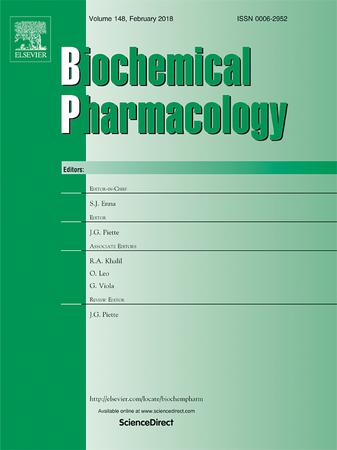Identification of pyrazole scaffold inhibitors targeting cyclin-dependent kinase 8 for potential use in pulmonary fibrosis
IF 5.3
2区 医学
Q1 PHARMACOLOGY & PHARMACY
引用次数: 0
Abstract
Idiopathic Pulmonary Fibrosis (IPF) is a disease that includes inflammation and scarring of the lung tissues. Cyclin-dependent kinase 8 (CDK8) is a target of interest due to its role in inflammatory pathways. CDK8 can also modulate the TGF-β/Smad signaling associated with IPF. Herein, a structure-based virtual screening (SBVS) campaign led to the identification of three CDK8 inhibitors. Testing of candidate inhibitors in protein and cellular assays confirmed CDK8 inhibition, with the most potent inhibitor producing an IC50 value of 398.8 nM. Computational analysis identified pharmacological interactions that lead to CDK8 inhibition. No significant cytotoxicity was observed when the inhibitor was treated in vitro. Further results showed that the inhibitor can disrupt proteins associated with the epithelial-mesenchymal transition (EMT) and reduce cell migration. Additionally, the inhibitor can disrupt the TGF- β1/Smad signaling axis in the nucleus, potentially impacting the transcription of IPF related protein expression, when treated in cells at 5 µM. Comparisons to structures of known CDK8 inhibitors showed the identified inhibitor to be structurally novel. When tested against a panel of kinases at 1 µM, the most potent inhibitor demonstrated a favorable CDK8 selectivity profile. The identification of the CDK8 inhibitors in this study can be used in future drug design studies and as CDK8 probes to explore alternative therapeutics for IPF.

鉴定靶向细胞周期蛋白依赖性激酶8的吡唑支架抑制剂在肺纤维化中的潜在应用
特发性肺纤维化(IPF)是一种包括肺组织炎症和瘢痕形成的疾病。细胞周期蛋白依赖性激酶8 (CDK8)由于其在炎症途径中的作用而成为感兴趣的靶标。CDK8还可以调节与IPF相关的TGF-β/Smad信号。在此,基于结构的虚拟筛选(SBVS)活动导致三种CDK8抑制剂的鉴定。候选抑制剂的蛋白质和细胞检测证实了CDK8的抑制作用,最有效的抑制剂产生398.8 nM的IC50值。计算分析确定了导致CDK8抑制的药理学相互作用。体外处理无明显的细胞毒性。进一步的研究结果表明,该抑制剂可以破坏与上皮-间质转化(EMT)相关的蛋白质,并减少细胞迁移。此外,当在细胞中处理5µM时,该抑制剂可以破坏细胞核中TGF- β1/Smad信号轴,可能影响IPF相关蛋白的转录表达。与已知CDK8抑制剂的结构比较表明,鉴定的抑制剂在结构上是新颖的。当对一组激酶在1µM下进行测试时,最有效的抑制剂显示出有利的CDK8选择性谱。本研究中CDK8抑制剂的鉴定可用于未来的药物设计研究,并作为CDK8探针探索IPF的替代治疗方法。
本文章由计算机程序翻译,如有差异,请以英文原文为准。
求助全文
约1分钟内获得全文
求助全文
来源期刊

Biochemical pharmacology
医学-药学
CiteScore
10.30
自引率
1.70%
发文量
420
审稿时长
17 days
期刊介绍:
Biochemical Pharmacology publishes original research findings, Commentaries and review articles related to the elucidation of cellular and tissue function(s) at the biochemical and molecular levels, the modification of cellular phenotype(s) by genetic, transcriptional/translational or drug/compound-induced modifications, as well as the pharmacodynamics and pharmacokinetics of xenobiotics and drugs, the latter including both small molecules and biologics.
The journal''s target audience includes scientists engaged in the identification and study of the mechanisms of action of xenobiotics, biologics and drugs and in the drug discovery and development process.
All areas of cellular biology and cellular, tissue/organ and whole animal pharmacology fall within the scope of the journal. Drug classes covered include anti-infectives, anti-inflammatory agents, chemotherapeutics, cardiovascular, endocrinological, immunological, metabolic, neurological and psychiatric drugs, as well as research on drug metabolism and kinetics. While medicinal chemistry is a topic of complimentary interest, manuscripts in this area must contain sufficient biological data to characterize pharmacologically the compounds reported. Submissions describing work focused predominately on chemical synthesis and molecular modeling will not be considered for review.
While particular emphasis is placed on reporting the results of molecular and biochemical studies, research involving the use of tissue and animal models of human pathophysiology and toxicology is of interest to the extent that it helps define drug mechanisms of action, safety and efficacy.
 求助内容:
求助内容: 应助结果提醒方式:
应助结果提醒方式:


